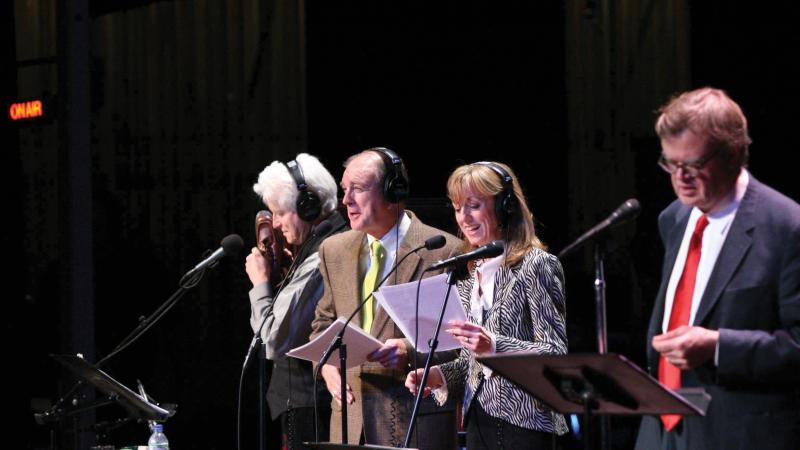No-nonsense Minnesotan that he is, Garrison Keillor warned us that he would one day depart A Prairie Home Companion.
Years before he formally announced that he would no longer write and perform in the St. Paul-based radio program—first transmitted on airwaves in 1974—Keillor forecast his decision on big screens around the country.
This was in the 2006 movie A Prairie Home Companion, starring Keillor, in which an ever-so-slightly fictionalized variant of the show was seen in the throes of its concluding broadcast. (The story was by Keillor and Ken LaZebnik.)
The on-screen setup was straightforward: An eager audience streams into the Fitzgerald Theater, the marquee of which is adorned with the likeness of its notable namesake, F. Scott. Inside, production assistants bustle like busy bees, while musical acts, including the Johnson Girls and cowboys Dusty and Lefty, ponder the past. The host, that would be Keillor, distracts himself from the sad significance of the evening by chitchatting continuously, even while he is putting on his pants. Meanwhile, smooth-as-silk detective Guy Noir keeps an eye on all, especially an ethereal blonde woman in a trench coat. Her presence may well be a bad omen, but, in truth, the program owes its demise to forces far more earthbound. A corporation headquartered in Texas bought what had been a family-run station, WLT, on which A Prairie Home Companion was broadcast. To paraphrase Emily in Our Town: Good-bye, Prairie Home Companion! Good-bye, Fitzgerald Theater, Johnson Girls, Dusty and Lefty . . .
In the movie, the show proceeds as planned, presenting a pleasing panoply of songs and laughs. Still donning napkins around his neck from being made up in the dressing room, Keillor launches into “Tishomingo Blues.” The Johnson Girls put all of their heart into “My Minnesota Home.” Dusty and Lefty are given featured parts, too. Throughout, sound-effects artists ply their craft, and advertisements for Powdermilk Biscuits and Bebop-A-Reebop Frozen Rhubarb Pie are briskly recited. The entertainment is so rich that it is easy to forget that when the curtain comes down, it will never rise again. “Every show,” Keillor says philosophically, “is the last show.”
The content of the imaginary Prairie Home Companion closely tracked the real-life Prairie Home Companion. Yes, movie stars—Meryl Streep, Lily Tomlin, and Kevin Kline among them—appeared in the film, but so did actual veterans of the show: Keillor played himself, and Sue Scott and sound-effects impresario Tom Keith were also in the film.
Everything rang true, everything, that is, except the plot.
The actual Prairie Home Companion did not cease transmission a decade ago. And WLT was not sold—in fact, there was no WLT. Then and now, the program is broadcast by Minnesota Public Radio. Moreover, for its loyal listeners, to contemplate the demise of A Prairie Home Companion would be like contemplating the demolition of a landmark. A liner note accompanying a fortieth-anniversary CD collection of samplings from the show emphasizes its multigenerational continuity: “Children were begat who grew up forced to listen to it and resented that and now listen freely and force their children. This is how a show goes on for 40 years.”
And the show will continue to go on, but beginning in the fall, it will do so without its founding father. A Prairie Home Companion ending? Impossible. But A Prairie Home Companion moving on without Garrison Keillor? It is happening, and soon.
Keillor’s final episode will air on July 2, the last show of the current 2015–16 season. Chris Thile, a mandolin player and periodic guest host, will take Keillor’s place permanently. To be sure, a transfer of power is not the same as the end of an era, but still: What will Saturday nights be without the sound of Keillor singing “Tishomingo Blues”?
In a recent e-mail interview with humanities magazine, the 73-year-old explained, in detail, his decision to withdraw from A Prairie Home Companion.
“I want to live a new life as a writer, a smaller life, not so many deadlines, the life I imagined when I was young, in which you sit in a room and wrangle sentences and paragraphs, a cup of coffee at hand,” Keillor says. “I never was cut out for performance, never had the ambition, just sort of sidled into it. Now I’m going to sidle out of it.”
The native of Anoka, Minnesota, did not grow up wanting to step before a mic, but to put pen to paper. In his autobiographical introduction to The Keillor Reader—a delightful compendium of writings published in 2014—he traced his literary ambitions to the sixth grade, when he composed a report detailing a trip to faraway New York City. “There is nothing like good material,” he wrote in the introduction. “You only had to say New York and there was an awestruck silence.” Two grades later, he talked his way into a sports-reporting job at a weekly newspaper, the Anoka Herald. There, he stood in awe of a printing press that made his stories available to “dozens, if not hundreds, of subscribers, men and women in kitchens all over Anoka eager for my account of the game.” Here, as throughout his work, Keillor seems to be poking fun, but is in fact expressing an authentically felt sentiment. “A person never gets over this,” he wrote, with a note of wonderment, of his time on the Anoka Herald, “the pleasure of seeing his own words in print.”
In the same book, Keillor wrote of an epiphany he experienced while a student at the University of Minnesota (from which he graduated in 1966). He realized that he was “not screwed up enough” to join the ranks of the great men of letters: “So I accepted that I could not be a true artist and that my future lay in the field of amusement.” Already, he was a fan of a trio of writers who wrote amusingly—and well—for the New Yorker: A. J. Liebling, S. J. Perelman, and E. B. White. He retains his enthusiasm for each.
“White was an essayist who found a literate everyday American voice, very elegant and utilitarian,” Keillor explains. “Liebling was a newspaperman who wrote better than anyone else about gamblers, hustlers, boxers, soldiers, reporters, good eaters, and lowlife in general. Perelman was a humorist who ventured into surrealist fable with splashes of vaudeville, carny barker, and candy salesman.”
As fate would have it, it was the New Yorker, a publication with considerably more clout than the Anoka Herald, that turned Keillor from aspirant to professional. In 1965, a journalism teacher named Bob Lindsay reckoned that Keillor’s talents and tastes made him a fit for the magazine, and he urged his pupil to give it the old college try. “He was brusque, not given to flattery,” Keillor wrote in the introduction to The Keillor Reader, “and when he said I should try to catch on at the New Yorker, I believed him.”
Submissions, and rejections, followed. Then, in 1969, a game changer came courtesy of the United States Postal Service. “I mailed my stories to 25 West 43rd Street in New York, as did thousands of English majors in the sixties, and a young woman assigned to comb through the slush pile found a story of mine and shot it upstairs to the big guys and they bought it,” Keillor says today. “Beautiful luck. I was living in St. Cloud and got the letter and was utterly stunned. It changed my life. How did it come about? I don’t want to know.” The story, “Local Family Keeps Son Happy,” was published in September 1970.
More beautiful luck: Also in 1969, Keillor accepted a position at Minnesota Public Radio, taking charge of a morning program. It was there that he first conjured the inhabitants of what would evolve into the fictitious town of Lake Wobegon, Minnesota, monologs about which would become the bread and butter, or meat and potatoes, if you prefer, of A Prairie Home Companion.
“In the early years of the morning show, I created sponsors—I’d grown up with commercial radio, after all—such as Jack’s Auto Repair, the Chatterbox Café, Ralph’s Pretty Good Grocery, and I needed a place to put them and that was Lake Wobegon,” Keillor says. “All those sponsors are long gone, and Lake Wobegon came to the fore as a home of characters I could talk about, the Krebsbachs and Bunsens and Tolleruds and Father Emil and Pastor Ingqvist and Darlene. A joke turned into a saga.”
And a sideline turned into the main tributary of Keillor’s career.
In 1971, Keillor’s morning-show stint came to an end, but in 1974, he reconsidered his leave-taking from radio when the New Yorker tasked him with writing about the Grand Ole Opry in Nashville. “The people I met were so genuine, so grateful for the chance to play music—Dolly Parton and Marty Robbins, Porter Wagoner, Bill Monroe, Stringbean—and it was awesome watching them from the wings,” Keillor says. “And I went back to Minnesota, wrote the story, did a couple shows at the Walker Art Center, decided to do a few more, and it turned into four decades.”
A Prairie Home Companion (as the show had come to be called) was not, however, the Grand Ole Opry, and its chances for success must have seemed uncertain. The music, of course, could not be beat: The fortieth-anniversary CD preserves appearances by such titans as Chet Atkins and Emmylou Harris, but what to make of Lake Wobegon, with its descriptions of the characters and customs of the Midwest? And what about the relentlessly up-tempo commercials (“Heavens, they’re tasty!” Keillor says of Powdermilk Biscuits) or the sometimes eccentric skits? “Diet Squad,” broadcast in 1982, seems representative: Studs Terkel, hamming it up, was cast as a Joe Friday-like cop assigned to ferret out illicit unhealthy meals. “You know what a guy can get for one porterhouse on the street now?” Terkel asks, tongue firmly in cheek.
The program proved widely appealing, which was, perhaps, a surprise to some, and it is now broadcast on 693 stations. Keillor says that the “liveness” of the show—“performers playing at the same time you hear them on your radio”—contributed to its success. “And it was a good time for the sort of acoustic music we offered. Emmylou Harris, Chet Atkins, Jethro Burns, John Prine, John Hartford, the Everlys—it was a rich broth,” he says. “And people enjoy being spoken to when there doesn’t seem to be a script—me talking to you, it is quite powerful on radio. So, the Lake Wobegon stories may have been a revelation to people who hadn’t grown up with that sort of thing. A great many listeners believed it was a real town, you know.”
Who could blame them? Keillor recites “The News from Lake Wobegon”—as that portion of the show has been styled since 1978—in a matter-of-fact, only moderately arch manner that convinces. On a recent episode, broadcast the week before Christmas, Keillor began with his signature introduction, which was immediately met by an appreciative burst of applause: “Well, it’s been a quiet week in Lake Wobegon, Minnesota, my home town, out there on the edge of the prairie.” The monolog that followed wandered hither and thither: Keillor began by admonishing Lake Wobegon denizens who took a tumble on icy sidewalks, following a cold snap (“They’re not wearing the right kind of shoes whatsoever”) before segueing into a pleasingly poetic account of a meteor shower (“‘falling stars’ we used to call them, until we knew better”).
Meanwhile, Pastor Liz—she of Lake Wobegon Lutheran Church—is said to have prompted parishioners to donate their spare coats and extra food to the needy, but Keillor mused that she would have been wiser to proffer a warning about the danger of walking on lakes that seem to be frozen solid but really aren’t (“She should have given a sermon about not walking out on ice until it really is all iced over”). In a seamless transition, Keillor shifted to the story of six men whose ice-fishing outing turned into an ordeal when they became stranded on a floe. Then, moving from anecdote to commentary, Keillor paused to reflect on what might happen when the hapless fellows tell their wives. “When you’ve done something just monumentally stupid, how quiet she is,” he said, speaking generally now. “Asks if you would like some eggs and bacon, brings you the paper, brings you your slippers, you look at her, is she smirking? She seems to be smirking, a little bit, and you just wish she would just come out and say it, just say it, just say, ‘You are dumb enough to be twins.’”
Loosey-goosey transitions are common on A Prairie Home Companion. Later in the same monolog, after commenting on the prodigious eating and sleeping habits of college students on Christmas break, Keillor digressed again: “Corinne Tollerud once slept for 16 hours coming home from college. They had to hold a mirror under her nostrils, pry open her eyelids and her eyes moved and so they let her sleep longer.” And then it was on to Corinne’s ex-boyfriend. After more than 13 minutes of the news Keillor said his good-byes: “Merry Christmas to you all from the people of Lake Wobegon, where all the women are strong, the men are good looking, and all the children are above average.”
Simply put, “The News from Lake Wobegon” is told in a kind of homespun stream of consciousness—Ulysses as reimagined by Booth Tarkington—that is utterly unique. In a 1982 article in the New York Times, writer Edward Fiske identified the segment as the show’s “centerpiece each week.” “His stories take off from events that everyone can recognize—the opening of duck hunting season, the death of a dog who liked to chase cars,” Fiske wrote, “and, as with them, his stories are for the most part autobiographical.” Indeed, Keillor’s kith and kin can be found among Lake Wobegon’s populace, but in fictionalized form. “My Aunt Elsie and Uncle Don were quite pleased to recognize themselves in the characters Myrna and Earl, which pleased me,” Keillor remembers now. “I once told a terrific story about Myrna winning the state fair baking contest with a lemon meringue pie on a broadcast from the state fair grandstand with 8,000 people present, including Elsie and Don. I’d say that was a high point of my career. I made two beloved relatives feel important yet be anonymous.”
It is tempting to connect this gentlemanly impulse—crafting a story inspired by dear relatives as a way of honoring them—with Keillor’s political outlook, which is detailed in his book Homegrown Democrat. “I am a liberal and liberalism is the politics of kindness,” he wrote, and throughout he emphasizes the wellspring of values that led to his support of the Democratic party. He prizes “collective expression,” embodied in such things as “the old Lutheran table grace” and children’s rhymes; this finds expression in “The News from Lake Wobegon,” too, which is so specific yet enjoyed by listeners of all backgrounds.
“Prizes for brilliance are a dime a dozen,” he wrote in Homegrown Democrat. “What’s really special is to write something that speaks for others.” And how’s this for a political platform? “Let not the sun set upon your wrath,” he wrote, referring to the current of “courtesy and kindness” that he believes informs most Democrats. “Be grateful for your gifts. Say good morning. Let the customer have his say. Let aggravation pass without response.”
A look at Keillor’s schedule sheds light on why he has an itch to retire. After devoting Sunday, Monday, and Tuesday to other writing projects (he has authored both novels and short story collections), by mid-afternoon Wednesday he develops sufficient “panic” to begin writing that week’s show. “I intend to start in the morning,” he recounts, “but I procrastinate.” By noon Friday, a “scriptage” has been e-mailed, and an actors’ read-through follows later that day. “They are terrific collaborators,” he says. “I don’t offer much direction, they are excellent cold readers, and from listening to them read, I get a much clearer idea of what needs to change, and I head home and revise until I can’t work any longer.” Keillor’s own Lake Wobegon monolog does not take shape until late Friday or Saturday—the day of the show. “And then go to the theater for a sound check around 1 p.m. for a 5 o’clock show,” he says. “Revision is still possible at that point, but around 4 or 4:30 the show is what it is and you make the best of it.”
Keillor is not set to leave radio entirely. He has become an admirable advocate on behalf of poetry. His interest and enthusiasm in the form are obvious in such energetically assembled collections as Good Poems and Good Poems for Hard Times, as well as on the radio program, the daily Writer’s Almanac.
The program uses its modest five-minute length to gently guide the listener through the literary canon. Writers’ birthdays often provide springboards for tiny biographical portraits (“It’s the birthday of the journalist A. J. Liebling, born Abbott Joseph Liebling in New York City, 1904,” Keillor said on an episode broadcast on Oct. 18, 2014). And, most important, each show is capped off with a poem, with writers ranging from Robert Frost to Philip Larkin.
If A Prairie Home Companion is a big church picnic, the Writer’s Almanac is a dainty box of pastries—no less lovely for being small and delectable. Keillor wants to keep the program going, he says, “if public radio stations don’t mind fitting a five-minute show into their schedules. Five minutes is all I need—it’s a little gem of a poem surrounded by three minutes of historical batting.”
Yet it is likely that listeners who continue to seek out Keillor on the Writer’s Almanac will be more aware than most of what has been lost in his exit from A Prairie Home Companion. To listen to Keillor reciting John Updike’s Dog’s Death is to know the power of radio: His strong, orotund voice, benevolent in tone and Midwestern in accent, is more distinctive than any image. To think that we will never again hear that voice impart items about Lake Wobegon, or enunciate the pleasures of Powdermilk Biscuits, is almost too much to bear.
But Keillor remains unassuming as he gets ready to “sidle” away. Before he goes, he remembers Sept. 29, 1999, when he was among eight artists and scholars selected to receive the National Humanities Medal, presented by President Bill Clinton and First Lady Hillary Rodham Clinton. “Deserving or not,” he says, “there I was, and I went to dinner at the White House and sat, tongue-tied, at a table with Steven Spielberg, Jim Lehrer, and the first lady, Hillary Clinton.”
He adds: “I ate everything on my plate and was a very good listener.”




